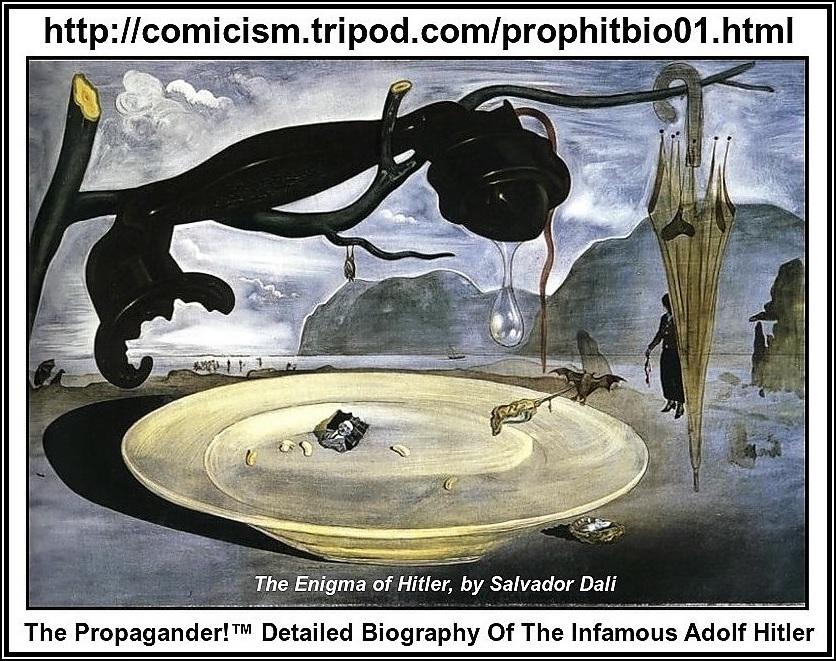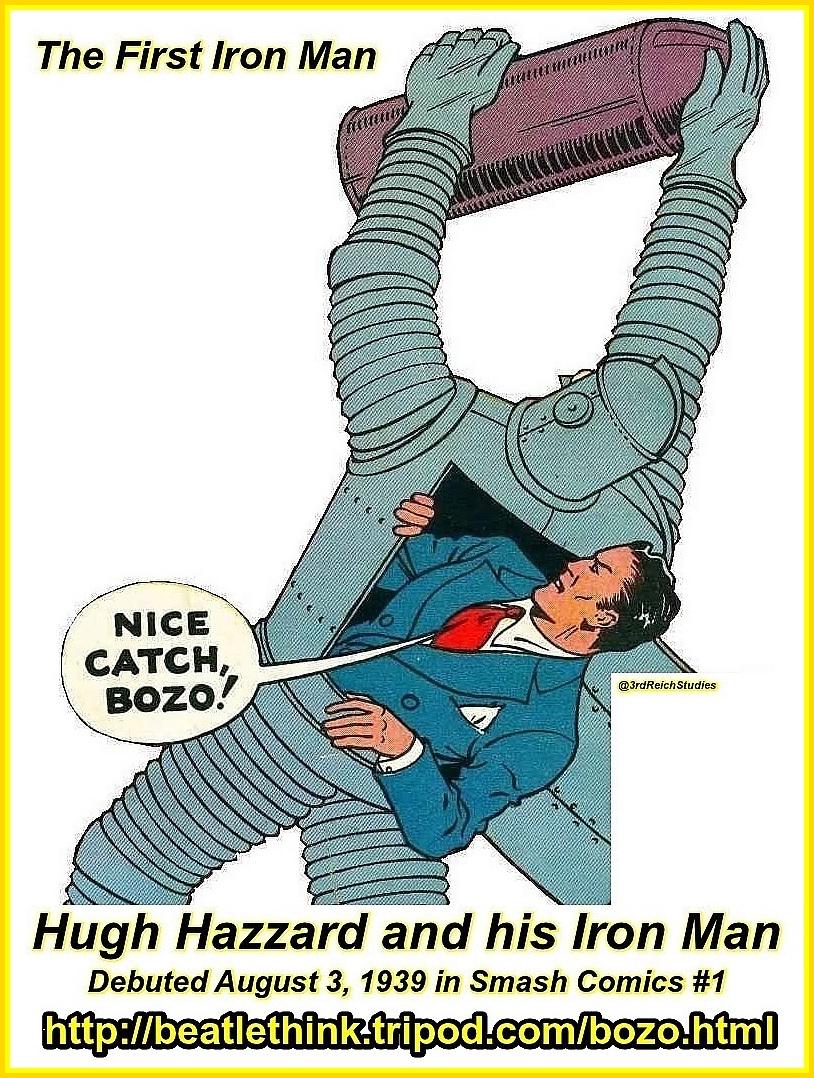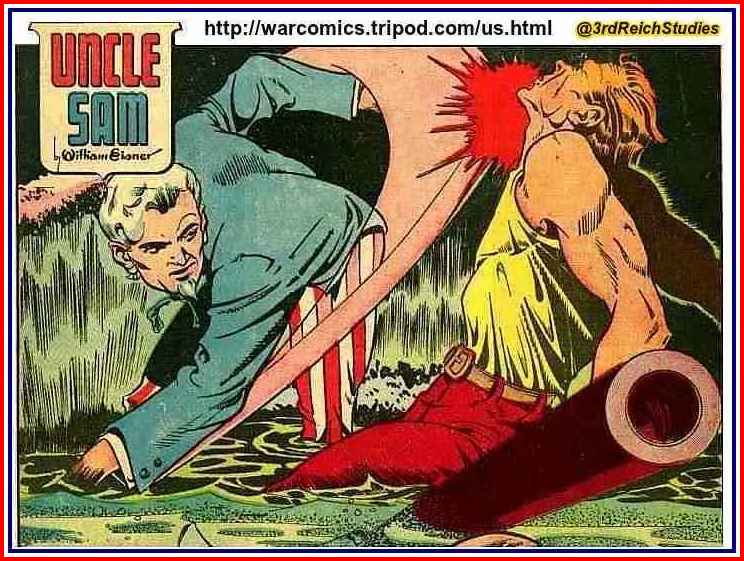The Propagander ™ FAQ
Was The Hitler Regime Right-Wing?
Among the issues that partisans on the Left and Right dispute concerning Adolf Hitler and his Nazis is whether National Socialism was Right-Wing or Left-Wing. While the respective definitions of what constitutes Left and Right have indeed undergone some variation over the decades, many of the core beliefs of each side have remained fairly consistent. But even if they were very different--which they are not--the question is still quite pertinent judged by current standards.
The first thing to keep in mind when discussing this issue is that Hitler had one primary goal, and two secondary goals. His primary goal was to rid Germany, and all of Europe, of all Jews, by any means necessary. His secondary goals were (1) to create a self-sufficient Greater Germany--immune to either blockade, or the vagaries of having to engage in trade in the international marketplace--and (2) to eliminate the perceived threat of Soviet Communism.
All of Hitler's policy initiatives, excepting these three major goals, were decided pragmatically. They were not consistent with any established ideology either of the Right or the Left. The only exception to this was his virulent strain of Radical Racialism, which took precedence over all other considerations. A demonstration of this: In the final stages of Hitler's war, as the Red Army was approaching from the East, and Patton, Bradley, and Montgomery were approaching from the West, Hitler gave first priority to transporting helpless Jews to Death Camps instead of soldiers to the Front. His hatred of them was that great.
Aside from his Racialism, Hitler was not an ideologue. It didn't matter to Hitler if a policy was of the Right or Left, as long as it assisted him in achieving his aims.
The second thing to keep in mind is that both Communism and Fascism have some traits in common. Most of these stem from the fact that both tended to perpetrate their respective Totalitarian regimes though Police State methods.
As Harold Marcuse, an American professor of modern and contemporary German history at the University of California, Santa Barbara, has suggested, in order to determine whether Hitler was a Rightie or a Leftie, a good place to start is Hitler's "25 Points", his Nazi Party Platform, which he announced in early 1920. This platform is a mix of both Right and Left policies, and can, and is, used to prove either side of the question. Hitler never denounced these 25 Points, even when many of the individual platforms became an embarrassment to him, and counter-productive to his aims. Indeed, Hitler referred to the 25 Points as 'inalterable', reasoning that constancy appealed to the electorate, and that any politician who changed his mind about stated policy--what we would today call "flip-flopping"--would be seen as weak and lacking conviction. Hitler never wanted to appear weak, under any circumstance.
The intent of labeling his Party "National Socialism" was to appeal to the large Communist vote from the Left, while simultaneously gaining the Nationalist vote on the Right. But while the Right policies were pursued with vigor, the Socialist aspects, excepting those that could strengthen his State in a practical way, were ignored.
The 25 Points were merely a party platform, much of which was never implemented. Like any other party platform, it was meant to gain support from a wide segment of the electorate in the elections of the 20's and early 30's. The Communists were very strong, as was the Nationalist Right, and the 25 Points were designed to lure Leftist and Rightist voters to the Nazi camp. As with all campaign promises, the test lies in which of these points were implemented once the promising party took power. In that event, it was soon clear that the National Socialists were about as Socialist as the People's Republic of China was a republic.
Let's take a hard look at these individual planks, while observing the extent to which each can be considered Right or Left, and the degree to which they were instituted or ignored.
Here is a link to the full text of the Points: The NSDAP Twenty-Five Points
(1-3) are statements of Radical Nationalism usually associated with the Right. The Left, while they give lip service too--and propagandize in favor of--equalitarian principles that reject the tenets of Nationalism, often adopt pro-Nationalist policies. They do this in order to maintain State Sovereignty and strong national borders. Communist nations of the Korean and Chinese type, as well as many other nationality-exclusive states, with their restrictions on citizenship to one ethnic group, are virtually identical in this regard. Therefore, these planks cannot be considered either Right or Left exclusively.
(4-9) is an extreme Nationalist right-wing position, declaring that "Only those of German blood ... may be members of the nation," and even denying citizenship--or any rights at all--to immigrants not of German 'blood.' Unlike this plank, which was carried out fanatically by the Nazis and culminated in the Holocaust, Leftist ideology of the USSR variety, in theory, is egalitarian and offered opportunities to all, regardless of race or ethnicity. For example, Trotsky was a Jew, Stalin was Georgian, Khrushchev was Ukrainian, etc..
(10) is another traditional Right-Wing position, and is opposed to the Left-Wing conception of a welfare state, saying that "It must be the first duty of every citizen to perform physical or mental work." This is a far cry from "From each according to his ability, to each according to his need".
(11) was a promise to "breaking of the slavery of interest." This far Left Communist plank was never carried out in any manner whatsoever, and was utilized cynically to sway the KDP voters to their side.
(12) is a Leftist, anti-Capitalist demand that war profits be subject to "ruthless confiscation." This never happened, and firms like Farban and Krupp would go on to make record-breaking profits from German rearmament and Hitler's war.
(13) was a typical Leftist anti-trust policy, the intent of which was to stifle monopolies, and also was never implemented. In fact, the opposite occurred as the big firms grew bigger by swallowing the smaller firms, starting with those owned by Jews. Though the Nazis did create an independent industrial empire under the SS, the Four-Year-Plan, and Organization Todt, it never in any way replaced private enterprise, and was similar in intent to many industrial enterprises created by the democratic Allies to assist the war effort.
(14) was a Socialist call for profit sharing in industry, and again never happened. It is interesting to note that the Nazis never carried out this program in any way other than to remove all Jews from the sector, which is something they did in all spheres as a matter of course.
(15) was a Socialist call for old-age insurance, and this promise was kept, except, of course, for Jews and "Euthanasia" victims. In any case, it was Bismarck, no Socialist in any sense, who had implemented the first state-sponsored program of this type. As Professor Marcuse has opined, this program does not indicate that the Nazis were Leftist "because those provisions were not universal, but only applied to narrowly defined citizens, excluding others".
Anyway, once Hitler started his war, many fewer Germans managed to live to an old age, and many who would have been eligible thus never collected this promised benefit.
(16–17) These planks are again typical Left-Wing policy. However, in practice the department stores were never abolished, and land reform never happened. Except for the fact that Jewish owned stores and land were "Aryanized", these are just broken promises made to get votes. Once the elections were over, the reforms were ignored.
(18–19) are Law and Order planks, often considered very Right-Wing; promises that were kept using the Gestapo and concentration camps. However, this is a case where the Nazis and Soviets pursued much the same policy, measures that are essential due to the realities of a Totalitarian Police State.
(20-21) were planks to strengthen the Germans mentally and physically so that Hitler's army, and his workers, would be strong. These were kept, but not for Gypsy's, Jews, Communists, etc.. The actual, practical impetus driving this plank to create a healthy and fit military machine and industrial support workforce. Again, most nations, regardless of ideology, institute similar public health initiatives. This plank can not be considered either Right or Left.
(22) was a plank to unify the armed forces, which is often thought of as basically a Right consideration, but in reality is universal to all sorts of various regimes.
(23) was the abolition of a Free Press, and is again something that is in common with both Far Right and Far Left Police States. Only nations closer to the Center ideologically, such as Republics and Democracies, actually have a Free Press, to varying degrees.
(24) is a plank for the uniting of Church and State, with the purpose of eliminating the Church as a force in politics. Again, the Soviets did much the same, but would have preferred to completely do away with religions altogether (as certain Nazis would have loved to do, such as Bormann). However, even in the Soviet Police State, public opinion was such that the Communists were never able to achieve this goal. And neither was Hitler. Again, only in Republics and Democracies is the Freedom of Religion usually a reality.
(25) is for a strong, central Federal Government and a curtailing of individual freedoms. Rightists say this is Leftist, Leftists say it is Rightist. It is neither. It is Totalitarian and is common to both the extreme Right and Left. Once again, only Republics and Democracies ever succeed, in any meaningful way, in ruling with reduced central authority and a relatively generous grant of individual Liberty.
Hitler eventually regretted having propagated these 25 Points, as well as laying out so much of his early Socialist-leaning planks in Mein Kampf, and his solution was to subsequently ignore the Leftist planks that did not strengthen his hand. Had he not done so, it is obvious that the support of big contributors in finance and industry, whose early monetary support of Hitler was so essential when the Party was vying for votes in the Weimar period, would never have been materialized.
The more Socialist of these points was, I stress, never implemented, and those who, in the early Nazi Party, most militantly supported these planks were either killed (such as Gregor Strasser), exiled (such as Otto Strasser), or sweet-talked by the "Austrian Charmer" into seeing things the Fuehrer's way (such as Goebbels, the Leftist of Hitler's disciples).
Again, the Socialist aspects that were actually retained were those that were necessary for the Police State, or to keep the workers happy and healthy, such as Strength Through Joy--Kraft durch Freude--a program designed to provide cheap vacations for the working class. But it is not to be supposed that the Nazis were proponents of Workers Rights, even while they made it possible for most workers to enjoy an occasional week or two at the beach. All German workers were issued paybooks, which were mandatory for employment. The employer would keep the paybook, and it was impossible for the worker to change jobs without that state-issued paybook in his hand. Further, during the war, ration coupons and rent subsidies were issued through the employer, giving the industrialists complete control of their workforce.
Even the KDF-Wagon program--the affordable People's Car (VW) that was meant to serve the goal of ensuring a contented working class--itself turned out to be a bit of a scam. It was a payroll deduction plan, where subscribers were issued stamps which they used to fill up their stamp books; five marks a week, or if a worker thought he could afford it, ten or fifteen marks a week. As soon as 200 stamps were collected, they could be redeemed for a car...theoretically. Production was due to begin in September of 1938, but only 54 cars actually rolled off the assembly line before Hitler's war necessitated production be converted to wartime needs. The money was never refunded by the Hitler regime.
This link details Hitler's VW debacle: The Secret History of the Volkswagen
It seems clear that the Socialist aspects of National Socialism were mostly for show. As Sebastian Haffner put it: "The real Hitlerian bedrock, his primal and lowest layer, which took shape during his Vienna period, is certainly not a fusion of nationalism and socialism but a fusion of nationalism and anti-Semitism. Anti-Semitism was the primary element, and this Hitler carried with him from the start, like a congenital hump. But his nationalism too, a very special Greater-German nationalism, undoubtedly dates back to his time in Vienna. His socialism, however, is most probably a later addition."
Conclusion: Hitler was a creature of the Right. The few Leftist aspects were instituted for pragmatic reasons, not due to any real ideological conviction.
 Copyright © 2011-2013
Walther Johann von Löpp
All Rights Reserved
Copyright © 2011-2013
Walther Johann von Löpp
All Rights Reserved
 Twitter: @3rdReichStudies
FB: Horrific 20th Century History
Twitter: @3rdReichStudies
FB: Horrific 20th Century History
























Disclaimer: The Propagander!™ includes diverse and controversial materials--such as excerpts from the writings of racists and anti-Semites--so that its readers can learn the nature and extent of hate and anti-Semitic discourse. It is our sincere belief that only the informed citizen can prevail over the ignorance of Racialist "thought." Far from approving these writings, The Propagander!™ condemns racism in all of its forms and manifestations.
Fair Use Notice: The Propagander!™may contain copyrighted material the use of which has not always been specifically authorized by the copyright owner. We are making such material available in our efforts to advance understanding of historical, political, human rights, economic, democracy, scientific, environmental, and social justice issues, etc. We believe this constitutes a "fair use" of any such copyrighted material as provided for in section 107 of the US Copyright Law. In accordance with Title 17 U.S.C. Section 107, the material on this site is distributed without profit to those who have expressed a prior interest in receiving the included information for research and educational purposes. If you wish to use copyrighted material from this site for purposes of your own that go beyond 'fair use', you must obtain permission from the copyright owner.


 Copyright © 2011-2013
Walther Johann von Löpp
All Rights Reserved
Copyright © 2011-2013
Walther Johann von Löpp
All Rights Reserved
 Twitter: @3rdReichStudies
FB: Horrific 20th Century History
Twitter: @3rdReichStudies
FB: Horrific 20th Century History




Copyright © 2011-2013 Walther Johann von Löpp All Rights Reserved
Twitter: @3rdReichStudies FB: Horrific 20th Century History



